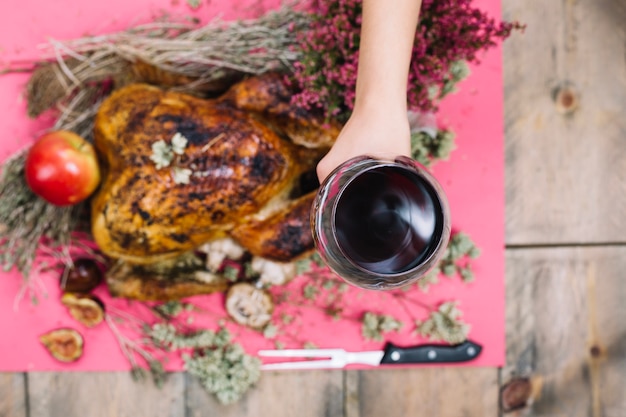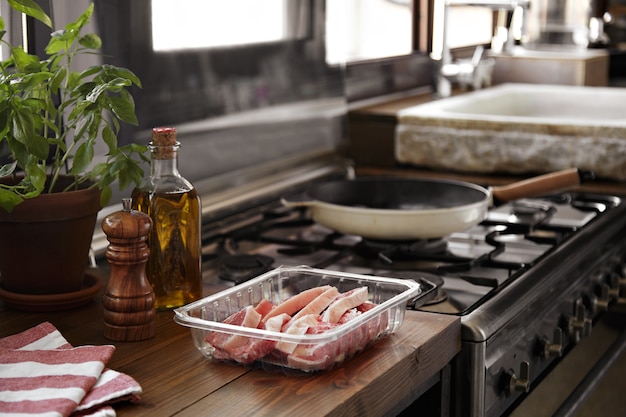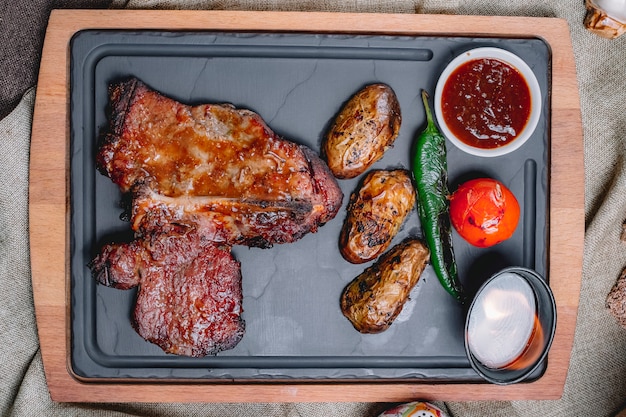There's something truly magical about slow-cooked pork shoulder. It's a transformation, taking a cut of meat that can be a bit tough and turning it into something melt-in-your-mouth delicious. I've been cooking for years, experimenting with all sorts of methods, but honestly, nothing beats the low and slow approach. Cooking a pork shoulder at 225°F (107°C) is like alchemy, turning a humble cut into a culinary masterpiece.
And the best part? It's incredibly forgiving! It's not like those delicate fillets that need careful attention. With a pork shoulder, even if you overcook it a little, you'll still end up with a fantastic meal. It's just that good.
This is your ultimate guide to slow-cooked pork shoulder at 225°F. We're going to dive into every step, from choosing the right cut to achieving that perfect bark, ensuring you end up with the most succulent, tender, and flavourful pork shoulder you've ever tasted.
(Part 1) Choosing the Perfect Pork Shoulder

Before we even think about the oven, we need to get the right piece of meat. You'll usually find two options at the butcher: Boston Butt and Picnic Shoulder. Both are fantastic for slow cooking, but they have their own unique qualities.
Boston Butt
Now, the name is a bit of a misnomer - it's actually from the shoulder blade, not the, well, butt! But it's known for its even fat distribution and marbling, making it exceptionally juicy.
- Pros: More marbling, incredibly forgiving if you overcook it, perfect for pulled pork.
- Cons: Can be a bit tougher than the picnic shoulder.
- Pros: Leaner, more flavourful, great for roasting and carving.
- Cons: Less forgiving when overcooked, can be a bit tougher.
- Salt: Use a generous amount of salt. It's not just about flavour; it draws out moisture, contributing to that delicious bark.
- Pepper: Black pepper adds a bit of heat and complexity to the flavour.
- Garlic Powder: A must-have for any pork dish, garlic powder adds a wonderful aroma and flavour, elevating the entire experience.
- Water: The simplest and most affordable option. It doesn't add any flavour, but it does the job perfectly.
- chicken broth: Adds a subtle, savoury flavour, enhancing the natural pork flavour without overwhelming it.
- Apple juice: Introduces a touch of sweetness and a lovely fruity aroma, complementing the pork beautifully.
- Beer: If you're feeling adventurous, beer adds a smoky, malty flavour, creating a bolder and more complex taste profile.
- Insert a meat thermometer into the thickest part of the shoulder.
- Ensure the temperature reaches at least 190°F (88°C).
- If it's not quite there yet, keep cooking for another hour or so. The pork shoulder will continue to tenderize as it cooks.
- Pulled pork sandwiches: A classic for a reason. Pile the pulled pork high on a bun, add your favourite toppings like coleslaw, pickles, and onions, and let the flavours explode in your mouth.
- Tacos: Another delicious way to use pulled pork. Warm some tortillas, fill them with the pork, your favourite toppings, and a squeeze of lime, for a truly satisfying and flavourful taco experience.
- Pork nachos: A fun and easy option. Pile the pulled pork on top of tortilla chips with your favourite toppings like cheese, salsa, and sour cream. It's a crowd-pleaser that's perfect for parties or casual gatherings.
- Carved pork: For a more formal meal, carve the roasted picnic shoulder into thick slices. Serve it with mashed potatoes, roasted vegetables, and a delicious gravy for a truly satisfying and elegant experience.
- Don't overcrowd the crock pot: If you're cooking more than one pork shoulder, make sure you leave enough space for the air to circulate. This ensures even cooking and prevents the pork from steaming rather than roasting.
- Use a meat thermometer: This is the most accurate way to check if your pork shoulder is cooked to perfection. Don't rely on guesswork - a meat thermometer takes the guesswork out of cooking and ensures a safe and delicious result.
- Experiment with different flavours: Don't be afraid to get creative with your seasoning and aromatics. Explore different flavour combinations, using herbs, spices, and even fruit juices to create unique and delicious pork shoulder experiences.
- Don't overcook it: It's better to err on the side of undercooking than overcooking. You can always cook it a bit longer if needed. But overcooking can make the meat dry and tough, so it's best to check the temperature regularly and take it out when it's done.
- Have fun: Slow cooking is all about relaxing and enjoying the process. So put on some music, pour yourself a drink, and let the magic happen. It's a truly rewarding experience, creating a delicious meal that you and your loved ones will savour.
Picnic Shoulder
The Picnic Shoulder, on the other hand, comes from the lower part of the shoulder, including the arm and leg. It's a bit leaner than the Boston Butt, with a thicker layer of fat on top. This can make it a bit more challenging to cook evenly, but it's incredibly flavourful and has a more distinct texture.
So, which one to choose? It's really down to what you're aiming for. I personally prefer the Boston Butt for pulled pork, where that juicy, tender texture is key. For a more formal meal, where you'll carve it, I love the Picnic Shoulder for its robust flavour. Ultimately, it's a matter of personal preference, and both options will lead to a delicious outcome.
(Part 2) Preparing the Pork Shoulder: A Symphony of Flavour

Now we're getting to the fun part - prepping the pork shoulder for its slow-cooking adventure. This is where we'll lay the groundwork for a truly incredible flavour experience.
Removing the Skin: A Matter of Texture
First things first, we need to address the skin. It's completely fine to leave it on, but I find that it renders down a bit too much fat, leading to a slightly chewy texture. For a more tender and melt-in-your-mouth experience, I prefer to remove it. Grab a sharp knife and carefully slice the skin off, leaving a thin layer of fat underneath. You don't want to remove all the fat, as that's what makes the pork shoulder so juicy!
Trimming the Fat: A Balancing Act
Next, we'll trim some of the excess fat. We want to remove any large chunks of fat that won't render down evenly, creating a more balanced flavour profile. But remember, we're not aiming for a lean cut of meat here - we want to leave a nice, even layer of fat all over the shoulder, contributing to the incredible juiciness of the finished product.
Seasoning the Pork Shoulder: A Canvas for Flavour
Now for the fun part - seasoning! The possibilities here are endless, but for a classic flavour, I love a simple salt, pepper, and garlic powder rub. It's a winning combination, enhancing the natural pork flavour without overwhelming it. However, feel free to get creative. A dash of paprika, chili powder, or cumin adds a warm, smoky depth, while brown sugar introduces a touch of sweetness.
My personal tip: Don't just sprinkle the seasoning on top. Rub it all over the pork shoulder, making sure to get it into all the crevices. This will ensure even flavour distribution, creating a more consistent and delicious result.
(Part 3) Setting Up the slow cooker: The Foundation for Flavour

We've prepped the pork shoulder, so now it's time to prepare its slow-cooking sanctuary: the crock pot. This is where we'll create the perfect environment for the magic to happen.
Choosing the Right Crock Pot: Size Matters
Any good-quality slow cooker will do, but you want to make sure you have enough room. Ideally, you should choose a crock pot that's at least 6 quarts (5.7 litres) in size. This gives your pork shoulder plenty of room to cook evenly without overcrowding, ensuring that every part gets the same gentle heat and transforms perfectly.
Adding Liquid: A Moist Environment is Key
The pork shoulder shouldn't be left alone in the crock pot. We need to create a moist environment to prevent it from drying out, and this is where liquid comes in. There are a few different options you can choose from, each with its own unique flavour contribution:
Personally, I love a combination of chicken broth and apple juice. It gives the pork shoulder a beautiful flavour without being too sweet or salty, allowing the natural pork flavour to shine through. It's a well-balanced combination that never fails to impress.
Adding Aromatics: A Depth of Flavour
Now here's a pro tip to take your pork shoulder to the next level: add some aromatics to your crock pot. Think onions, garlic, carrots, celery - these vegetables will release their flavour as they cook, infusing the pork shoulder with an incredible depth of flavour. Don't forget the herbs, like bay leaves and thyme - they add a subtle, fragrant touch that elevates the entire experience.
(Part 4) Slow Cooking the Pork Shoulder: The Art of Patience
We've prepped the pork shoulder, we've got the crock pot ready, now it's time for the slow-cooking magic to unfold. And trust me, it's incredibly simple. It's all about patience and allowing the heat to work its magic on the meat.
Setting the Temperature: Low and Slow is the Key
As I mentioned, we're going to cook the pork shoulder at a low and slow temperature of 225°F (107°C). This gentle heat is what breaks down the collagen in the meat, transforming it from tough to incredibly tender. It's a slow and steady process that rewards you with an incredibly succulent and satisfying result.
cooking time: A Matter of Size
Now, the cooking time can vary depending on the size of the pork shoulder and the thickness of the fat layer. But a good rule of thumb is to cook it for 8-10 hours. Remember, it's not about rushing the process; it's about letting the heat work its magic. The longer you cook it, the more tender the meat will become.
The most accurate way to know if your pork shoulder is done is by using a meat thermometer. Aim for an internal temperature of at least 190°F (88°C) for a safe and delicious result.
Checking for Doneness: Signs of Perfection
Here's how to know your pork shoulder is ready:
You'll also know it's done when the meat is incredibly tender and pulls apart easily with a fork. You should also see a lot of juices rendered out of the pork shoulder, which indicates that it's cooked perfectly. This juicy, flavorful broth is what will make your pulled pork sandwiches or roasted pork so delicious.
(Part 5) Shredding the Pork Shoulder: The Final Touch
The pork shoulder is cooked to perfection, and it's now time to shred it for those irresistible pulled pork sandwiches. Or, if you've chosen the picnic shoulder, it's ready for carving.
Shredding the Pork: A Gentle Touch
To shred the pork shoulder, use two forks to pull the meat apart. It's a gentle process, so you don't want to over-shred it. Aim for some nice, chunky pieces for texture, creating a pleasing contrast to the tender, juicy meat. You can also use a pair of tongs or even a stand mixer with a paddle attachment, if you're feeling lazy.
Making Pulled Pork: A culinary adventure
With your shredded pork, you can now start creating. For pulled pork, mix the shredded pork with your favourite sauce. I love a tangy, smoky barbecue sauce, but the world is your oyster - feel free to experiment with different flavours, creating your own unique signature pulled pork.
Carving the Pork: A Feast for the Eyes
If you chose the picnic shoulder, you'll want to carve it into thick slices. It's a great option for a more formal meal, where you want to showcase the beautiful texture and delicious flavour of the roasted pork. Serve it with your favourite sides, like mashed potatoes, roasted vegetables, and a delicious gravy, for a truly satisfying experience.
(Part 6) Creating the Perfect Bark: A Crispy, Delicious Touch
Let's talk about that crispy, delicious bark that forms on top of the pork shoulder. It's a symphony of textures and flavours, adding another dimension to the already delicious pork. Here's how to achieve that perfect bark, turning your pork shoulder into a culinary masterpiece.
Raising the Temperature: A Finishing Touch
After the pork shoulder has cooked for several hours, you can raise the temperature of your oven to 400°F (204°C). This final burst of heat will help to crisp up the bark, giving it that amazing texture and a beautiful, golden-brown colour. This is a crucial step in transforming the pork shoulder into something truly special.
Basting the Pork: A Touch of Moisture
You can also baste the pork shoulder with a mixture of apple cider vinegar and water to help create a lovely, crispy bark. The vinegar adds a touch of acidity, counterbalancing the richness of the pork, while the water helps to keep the meat moist. Just brush it on every hour or so during the last few hours of cooking, ensuring a consistent, even browning.
Letting It Rest: Time for Relaxation
Once the pork shoulder is cooked, let it rest for at least 30 minutes before shredding or carving. This allows the juices to redistribute, ensuring that the meat is even more tender and juicy. It's a crucial step in maximizing the flavour and creating a truly exceptional dining experience.
(Part 7) Serving and Storing: Sharing the Delight
You've got your delicious pork shoulder, now it's time to serve it up and share the delight!
Serving Options: A Feast of Possibilities
Here are a few ideas to inspire your culinary creativity:
Storing Leftovers: Sharing the Joy
If you have any leftovers, store them in an airtight container in the fridge for up to 3 days. You can also freeze them for up to 3 months. Just defrost them in the fridge overnight before reheating and enjoying the delicious leftovers.
(Part 8) Tips and Tricks: Mastering the Art of Slow Cooking
Here are a few more tips and tricks to ensure your slow-cooked pork shoulder is a triumph:
(Part 9) FAQs: Solving the Mysteries of Slow-Cooked Pork
Here are some frequently asked questions about slow-cooked pork shoulder:
1. Can I use a dutch oven instead of a slow cooker?
Absolutely! You can definitely use a Dutch oven to slow cook your pork shoulder. Just preheat the oven to 225°F (107°C) and cook the pork shoulder for 8-10 hours. The Dutch oven creates a similar, slow, even heat, allowing the pork to cook perfectly.
2. What happens if I overcook the pork shoulder?
Don't worry, it's not the end of the world! If you overcook the pork shoulder, it will be a bit drier, but it will still be edible. Just make sure to shred it carefully so it doesn't fall apart too much. You can also add a bit of broth or sauce to help moisten it up. It's not ideal, but you can still salvage the meal and enjoy a delicious pork dish.
3. How can I make the bark even crispier?
You can increase the temperature to 450°F (232°C) for the last 30 minutes of cooking. This will help to create a super crispy bark. You can also brush the pork shoulder with a glaze made from honey, soy sauce, and brown sugar for extra crispness. The glaze adds a beautiful, glossy finish and enhances the flavour profile, creating a truly irresistible bark.
4. Can I add vegetables to the slow cooker?
Yes, you can! Adding vegetables like potatoes, carrots, and onions will give you a complete meal. Just make sure to add them during the last hour of cooking, so they don't get mushy. This creates a one-pot meal that's easy to prepare and incredibly satisfying.
5. What are some other ways to use leftover pork shoulder?
The possibilities are endless! You can use leftover pork shoulder in tacos, burritos, quesadillas, pasta dishes, salads, and even soups. Just get creative and use your imagination! It's a truly versatile ingredient that can add delicious flavour to a wide range of dishes.
I hope this guide has been helpful and inspires you to give slow-cooked pork shoulder a try. It's a truly delicious and versatile dish that will impress your family and friends. And remember, slow cooking is all about relaxing and enjoying the process. So grab your favourite tunes, pour yourself a drink, and let the magic happen!
Everyone is watching

Perfect Rice Every Time: The Ultimate Guide to Cooking Rice
Cooking TipsAs a self-proclaimed foodie, I've always been a bit obsessed with rice. It's the foundation of countless cuisi...

Prime Rib Roast Cooking Time Chart: Per Pound Guide
Cooking TipsPrime rib roast. Just the name conjures images of lavish dinners, crackling fires, and hearty laughter. It’s ...

The Ultimate Guide to Cooking Asparagus: Tips, Techniques, and Recipes
Cooking TipsAsparagus. The mere mention of this spring delicacy conjures up images of vibrant green spears, crisp and burs...

Ultimate Guide to Cooking the Perfect Thanksgiving Turkey
Cooking TipsThanksgiving. Just the word conjures up images of overflowing tables laden with delicious food, the scent of r...

How Long to Bake Potatoes in the Oven (Perfect Every Time)
Cooking TipsBaked potatoes are a staple in my kitchen. They're incredibly versatile, delicious, and surprisingly easy to m...
